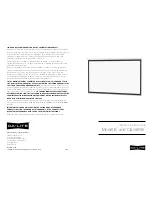
1.
Connect the test set for injection of voltage and current corresponding to the
mode to be used in the application. If a three phase test set is available this could
be used for all the modes. If a single phase current/voltage test set is available the
test set should be connected to a selected input for one phase current and voltage.
2.
Adjust the injected current and voltage to the set rated values in % of
IBase
and
UBase
(converted to secondary current and voltage). The angle between the
injected current and voltage shall be set equal to the set direction
Angle1
, angle
for stage 1 (equal to 0° for low forward power protection and equal to 180° for
reverse power protection). Check that the monitored active power is equal to
100% of rated power and that the reactive power is equal to 0% of rated power.
3.
Change the angle between the injected current and voltage to
Angle1
+ 90°.
Check that the monitored active power is equal to 0% of rated power and that the
reactive power is equal to 100% of rated power.
4.
Change the angle between the injected current and voltage back to
Angle1
value.
Increase the current slowly from 0 until the START1 signal, start of stage 1, is
activated. Check the injected power and compare it to the set value
Power1
,
power setting for stage 1 in % of
Sbase
.
5.
Increase the current to 100% of
IBase
and switch the current off.
6.
Switch the current on and measure the time for activation of TRIP1, trip of stage
1.
7.
If a second stage is used, repeat steps
for the second stage.
12.5.11.2
Completing the test
Continue to test another function or end the test by changing the
TestMode
setting to
Off
. Restore connections and settings to their original values, if they were changed for
testing purposes.
12.5.12
Negative-sequence time overcurrent protection for machines
NS2PTOC
When inverse time overcurrent characteristic is selected, the operate
time of the stage will be the sum of the inverse time delay and the set
definite time delay. Thus, if only the inverse time delay is required, it
is of utmost importance to set the definite time delay for that stage to
zero.
In version 2.0, a typical starting time delay of 24ms is subtracted from
the set trip time delay, so that the resulting trip time will take the
internal IED start time into consideration.
12.5.12.1
Verifying settings by secondary injection
Section 12
1MRK502053-UEN B
Testing functionality by secondary injection
168
Generator protection REG670 2.0 IEC
Commissioning manual
Summary of Contents for REG670 2.0 IEC
Page 1: ...Relion 670 series Generator protection REG670 2 0 IEC Commissioning manual ...
Page 2: ......
Page 16: ...10 ...
Page 30: ...24 ...
Page 58: ...52 ...
Page 62: ...56 ...
Page 76: ...70 ...
Page 90: ...84 ...
Page 94: ...88 ...
Page 108: ...102 ...
Page 246: ...240 ...
Page 252: ...246 ...
Page 267: ...261 ...
















































